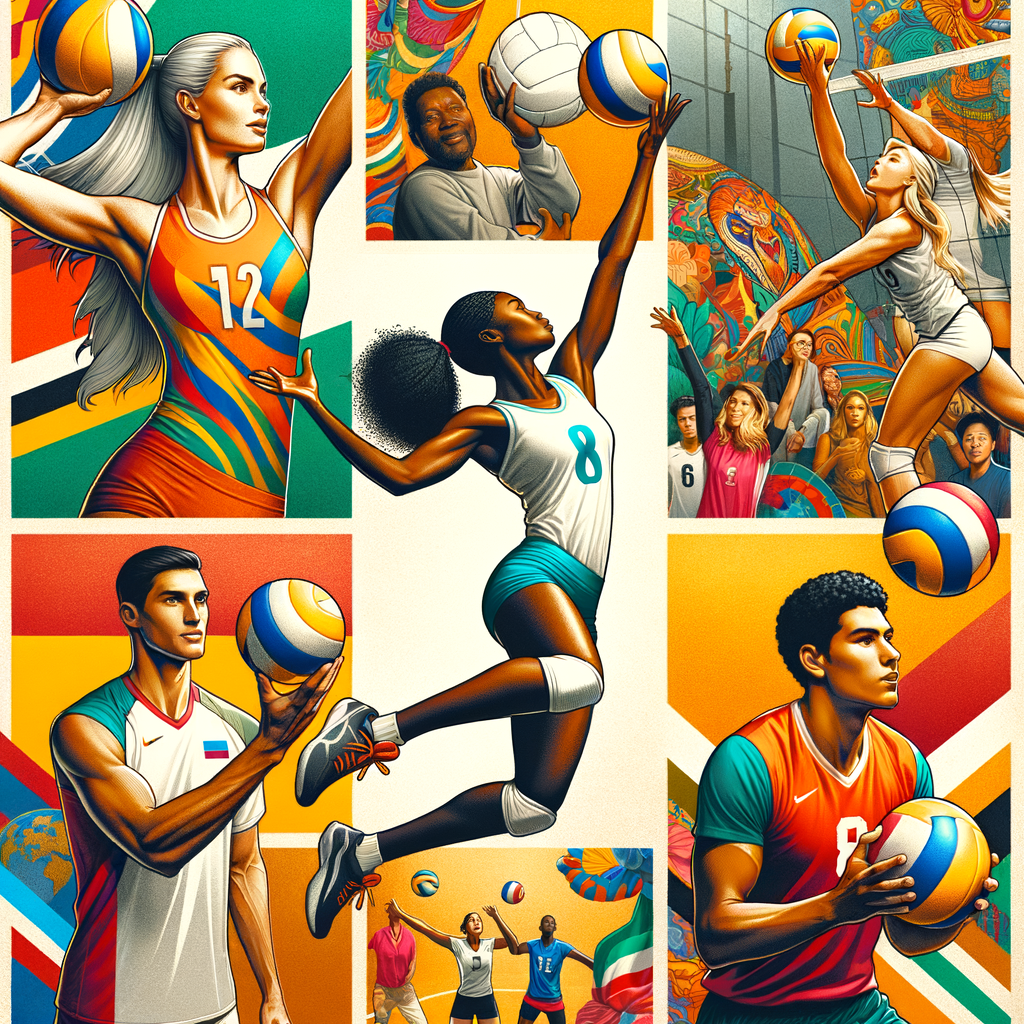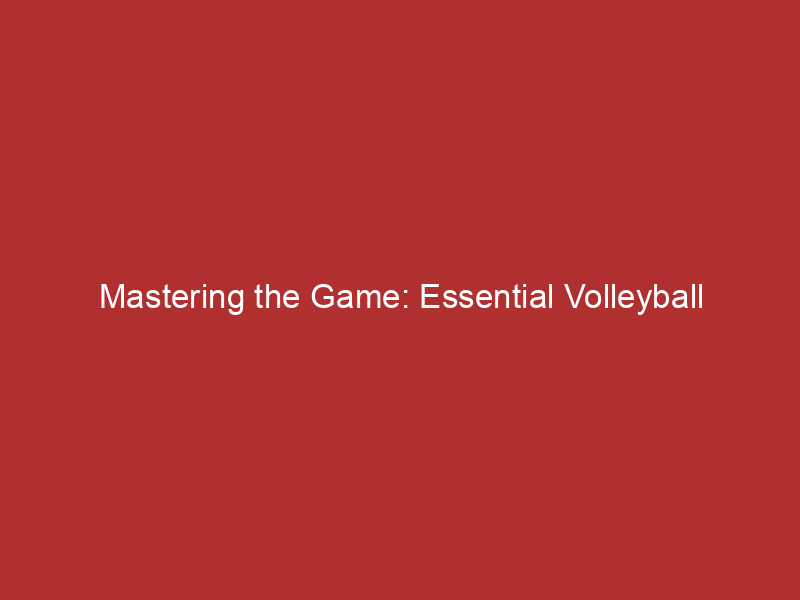
Introduction: Global Diversity in Volleyball
Welcome to our exploration of the global diversity in volleyball. In this post, we will delve into how volleyball has spread across the globe, and the rich diversity it showcases in the world of sports. We will provide you with exciting data, interesting facts, and inspiring stories from around the world.
- Exploring the global reach of volleyball
Volleyball, a sport that originated in the United States, has now become a global phenomenon. It’s played in over 200 countries worldwide, from the sandy beaches of Brazil to the bustling cities of China. According to the International Volleyball Federation (FIVB), there are over 800 million people playing volleyball at least once a week worldwide. That’s a lot of people enjoying the sport!
But what makes volleyball so popular? It’s a sport that can be played by anyone, anywhere. All you need is a ball and a net. You can play it on the beach, in a park, or even in your backyard. It’s a sport that brings people together, regardless of their age, gender, or background.
- Understanding the diversity in sports
When we talk about diversity in sports, we’re not just talking about different countries participating. We’re talking about the variety of people who play the sport. Volleyball is a sport that embraces diversity. It’s played by men and women, young and old, professionals and amateurs. It’s a sport that doesn’t discriminate.
Take, for example, the Paralympic Games. Volleyball has been a part of the Paralympics since 1976, allowing athletes with disabilities to participate and compete at the highest level. It’s a testament to the inclusivity of the sport.
So, as we delve deeper into the world of volleyball, let’s celebrate the diversity that makes this sport so special. From the players on the court to the fans in the stands, volleyball truly is a global game.
Volleyball Player Profiles: A Global Perspective
In this section, we will delve into the profiles of some of the most outstanding volleyball players from North America. These athletes have not only made significant contributions to their teams but have also played a pivotal role in shaping the sport in their region.
Profiles of Volleyball Players from North America
-
Karch Kiraly
Known as one of the greatest volleyball players of all time, Karch Kiraly hails from the United States. He is the only player to have won Olympic gold medals in both indoor and beach volleyball. Kiraly’s exceptional skills and leadership have left an indelible mark on the sport.
-
Misty May-Treanor
Misty May-Treanor, also from the United States, is considered one of the best female beach volleyball players. She has three Olympic gold medals to her name and holds the record for the most career wins by a female player. Her determination and passion for the sport have inspired many young athletes.
-
Gavin Schmitt
Canada’s Gavin Schmitt is known for his powerful spikes and serves. He played a crucial role in leading the Canadian national team to their best finish in the World League, securing a fifth-place finish in 2013. Schmitt’s dedication to the sport has made him a role model for aspiring volleyball players in Canada.
These players, with their unique skills and contributions, have not only made a name for themselves but have also elevated the status of North American volleyball on the global stage. Their stories serve as a testament to the talent and diversity present in the sport.
Profiles of Volleyball Players from Europe
Europe has produced some of the world’s most talented volleyball players. Here, we will take a closer look at three of these exceptional athletes.
-
Player 1: Ivan Zaytsev
Ivan Zaytsev, also known as “The Tsar”, is a renowned Italian volleyball player of Russian descent. Born in 1988, Zaytsev has made a significant impact on the sport with his powerful serves and spikes. He has won numerous awards, including the Best Opposite Spiker at the 2013 European Championship.
-
Player 2: Bartosz Kurek
Bartosz Kurek is a Polish volleyball player who was born in 1988. He is known for his exceptional skills and versatility on the court. Kurek was named the Most Valuable Player (MVP) at the 2018 World Championship, leading his team to victory.
-
Player 3: Wilfredo Leon
Wilfredo Leon, born in 1993, is a Cuban-born player who now represents Poland. Known for his powerful attacks and serves, Leon has been a key player in several international tournaments. He was part of the Polish team that won the 2019 European Championship.
| Player | Country | Notable Achievements |
|---|---|---|
| Ivan Zaytsev | Italy | Best Opposite Spiker at the 2013 European Championship |
| Bartosz Kurek | Poland | MVP at the 2018 World Championship |
| Wilfredo Leon | Poland | Part of the winning team at the 2019 European Championship |
These players have not only excelled in their sport, but they have also contributed to the global diversity of volleyball. Their achievements serve as an inspiration to aspiring athletes around the world.
Volleyball Player Profiles: A Global Perspective
Profiles of Volleyball Players from Asia
Asia has produced some of the world’s most talented and renowned volleyball players. Let’s take a closer look at three such players who have made significant contributions to the sport.
-
Kim Yeon-koung
Kim Yeon-koung, from South Korea, is often considered one of the best female volleyball players in the world. She has led her national team to numerous victories, including a gold medal at the 2014 Asian Games. Kim’s powerful spikes and exceptional leadership skills have earned her a place in the hearts of volleyball fans worldwide.
-
Kunihiro Shimizu
Japan’s Kunihiro Shimizu is a force to be reckoned with on the volleyball court. Known for his powerful serves and precise attacks, Shimizu has been a key player for Japan’s national team for over a decade. His passion for the game and dedication to his team are truly inspiring.
-
Zhu Ting
Zhu Ting is a Chinese professional volleyball player who has achieved remarkable success at a young age. She led the Chinese national team to a gold medal at the 2016 Rio Olympics and was named the Most Valuable Player. Zhu’s exceptional skills and determination make her a role model for aspiring volleyball players.
These players have not only excelled in their sport, but they have also broken barriers and inspired millions of fans. They are true ambassadors of volleyball, demonstrating the power of dedication, hard work, and team spirit.
International Volleyball Players: Breaking Barriers
As we delve deeper into the world of volleyball, it’s essential to highlight the individuals who have broken barriers and paved the way for others. These international players have not only shown exceptional skill on the court, but also demonstrated the power of diversity in the sport.
- Case study: Player who broke barriers
- Impact of diversity in volleyball
Let’s take a look at the inspiring story of a player who has broken barriers in the world of volleyball – Karch Kiraly. Born in the United States, Kiraly is considered one of the greatest volleyball players of all time. He has won numerous awards and championships, both on the national and international stages.
However, what truly sets Kiraly apart is his dedication to promoting diversity in the sport. He has worked tirelessly to encourage players from all backgrounds to participate in volleyball, breaking down barriers of race, gender, and socio-economic status. His efforts have not only enriched the sport but also created opportunities for countless individuals around the world.
Diversity in volleyball has a profound impact on the sport. It brings together players from different backgrounds, cultures, and experiences, creating a rich tapestry of talent. This diversity not only enhances the competitive nature of the sport but also promotes mutual respect and understanding among players.
Furthermore, diversity in volleyball serves as a powerful tool for social change. It challenges stereotypes, fosters inclusivity, and inspires future generations to embrace diversity. In essence, volleyball becomes more than just a sport – it becomes a platform for promoting unity and equality.
In conclusion, international volleyball players who break barriers play a crucial role in shaping the sport. They not only contribute to the game’s competitive spirit but also promote diversity and inclusivity. As we continue to celebrate and support these players, we can look forward to a future where volleyball truly reflects the global community it represents.
Volleyball Around the Globe: A Comparative Analysis
In this section, we will delve into the diverse styles of volleyball played across different continents. We will focus on the North American, European, and Asian styles, highlighting their unique characteristics and how they reflect the cultural nuances of their respective regions.
Comparing Volleyball Styles Across Continents
Volleyball, though universally played, varies in style and tactics across continents. Let’s take a closer look at the distinct styles of North America, Europe, and Asia.
- North American style
- European style
- Asian style
The North American style of volleyball is characterized by its fast-paced and aggressive gameplay. The players are known for their powerful serves and spikes, which are often used to quickly end rallies. This style reflects the competitive spirit and athleticism prevalent in North American sports culture.
European volleyball, on the other hand, is more strategic and tactical. The players often employ a variety of formations and complex plays, emphasizing teamwork and coordination. This style mirrors the European emphasis on strategy and precision in sports.
Asian volleyball is renowned for its emphasis on agility and technical skills. The players are often smaller in stature compared to their Western counterparts, but they make up for it with their speed, agility, and precision. This style showcases the Asian values of discipline, hard work, and technical mastery.
Understanding these different styles of volleyball not only enriches our appreciation of the sport but also underscores the fascinating ways in which culture influences sports and vice versa.
Impact of Cultural Diversity on Volleyball Tactics
Let’s explore how cultural diversity impacts the tactics used in volleyball. These impacts are not just interesting, but they also show us how the beautiful game of volleyball is played differently around the world.
- Adaptation of Unique Playing Styles
- Enhancement of Team Dynamics
- Improvement of Skills and Techniques
Cultural diversity brings about a variety of playing styles in volleyball. For instance, the fast and agile style popular in Asian countries contrasts with the power-focused style often seen in North America. This diversity in playing styles forces teams to continuously adapt their tactics to counter different styles, making the game more dynamic and exciting.
When players from different cultures come together, they bring unique perspectives and ideas. This diversity can lead to the development of innovative tactics that a homogenous team might not think of. For example, a player from Brazil might introduce a new serving technique that’s popular in their home country, which could then be incorporated into the team’s overall strategy.
Cultural diversity can also lead to the improvement of skills and techniques within a team. Players can learn from each other’s strengths, leading to a more well-rounded team. For example, a player from Europe might excel in defensive strategies, while a player from Africa might have exceptional attacking skills. By learning from each other, the team can improve its overall performance.
In conclusion, cultural diversity has a significant impact on volleyball tactics. It encourages the adaptation of unique playing styles, enhances team dynamics, and leads to the improvement of skills and techniques. So, the next time you watch a volleyball match, take a moment to appreciate the diverse tactics on display, brought about by the cultural diversity of the players.
Conclusion: The Future of Global Diversity in Volleyball
As we reach the end of our exploration into the global diversity of volleyball, it’s clear that this sport has a bright and diverse future. Volleyball has proven to be a universal language, uniting people from different backgrounds, cultures, and nations. Let’s summarize our key takeaways and look at the future prospects.
- Key takeaways
- Volleyball is a truly global sport, played and enjoyed by people from all corners of the world.
- International volleyball players are breaking barriers and inspiring others to do the same.
- Comparative analysis shows that different regions have unique approaches to the game, enriching its global diversity.
- Future prospects
- With the increasing globalization of the sport, we can expect even more diversity in the future. New nations are likely to emerge on the volleyball scene, bringing their unique styles and techniques.
- Initiatives to promote volleyball in underrepresented regions will further enhance global diversity.
- Technological advancements may also influence how the game is played and viewed, potentially attracting a broader, more diverse audience.
In conclusion, the future of global diversity in volleyball looks promising. As the sport continues to grow and evolve, we can look forward to seeing even more countries and cultures represented on the volleyball court. This global diversity is not just about the number of nations playing the game, but also about the different styles, techniques, and strategies that they bring. It’s this diversity that makes volleyball such a fascinating and inclusive sport.






